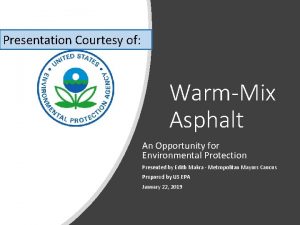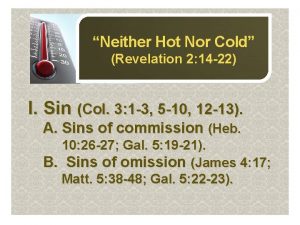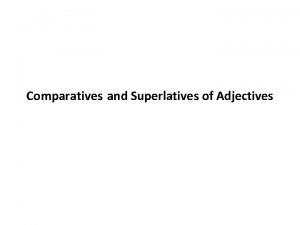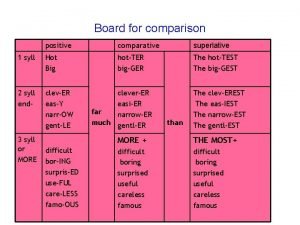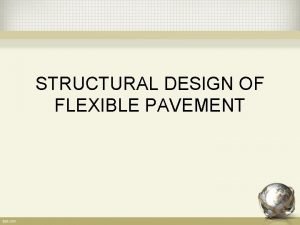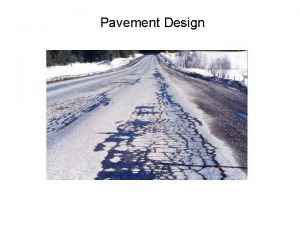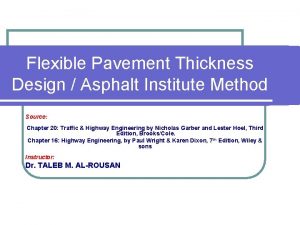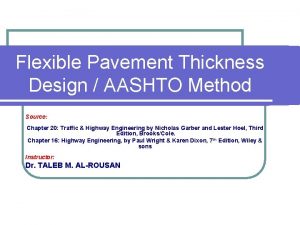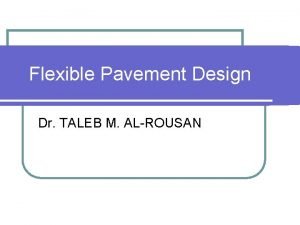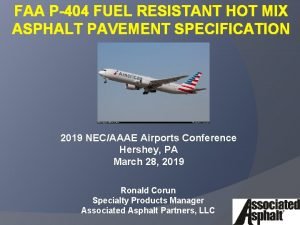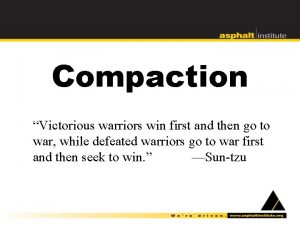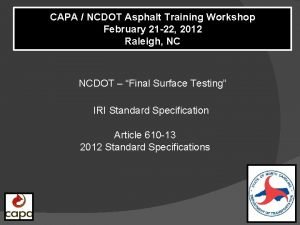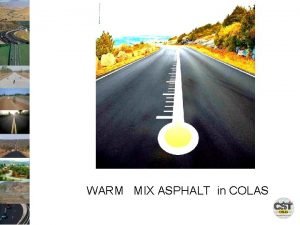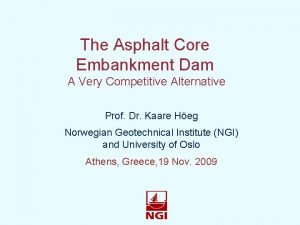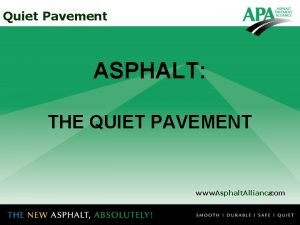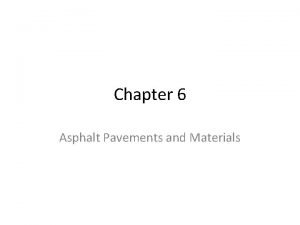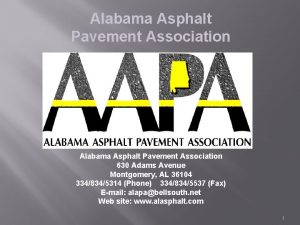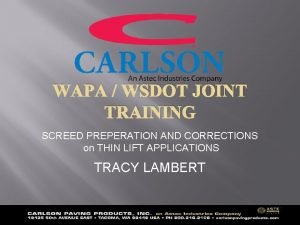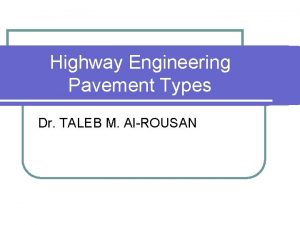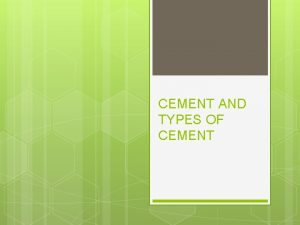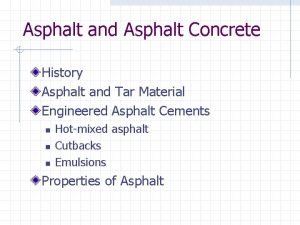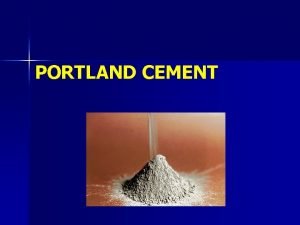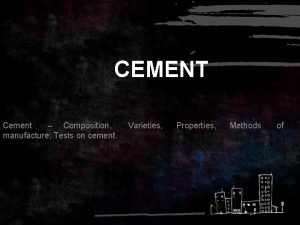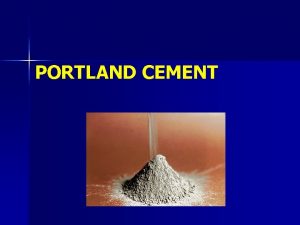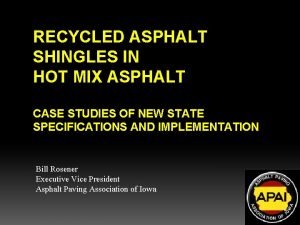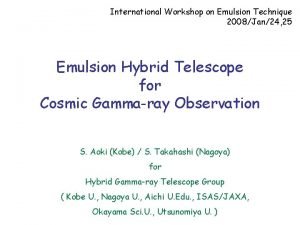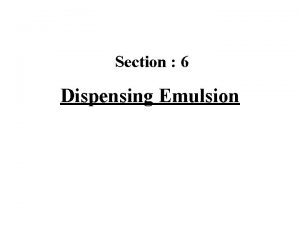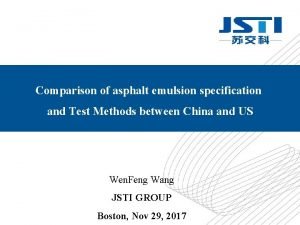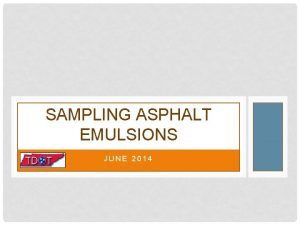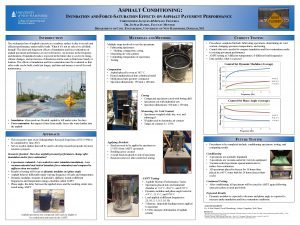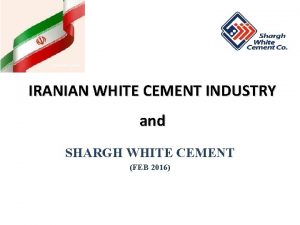Comparative Analysis of Emulsion and Hot Asphalt Cement





















- Slides: 21

Comparative Analysis of Emulsion and Hot Asphalt Cement Chip Seal Performance Douglas D. Gransberg, P. E. , C. C. E. University of Oklahoma

Project Facts J Tx. DOT Atlanta District 342 projects § All built since 1996 § Same seal coat contractor § Same Tx. DOT Area Office did design/ construction administration § Same aggregate § Same asphalt supplier § 165 used CRS-2 P no precoat § 177 used AC 15 -5 TR with precoat §

Emulsion Binder Usage in Texas Use of Emulsion as Binder CRS-2 H HFRS-2 P HFRS CRS-2 P 0 2 4 6 No. of Districts 8 10 12

Hot AC Binder Usage in Texas Use of Asphalt Cement as Binder AC 10 -latex AC 5 -latex AC 10 AC 5 AC 15 -5 TR AC 15 P 0 2 4 6 8 10 12 No. of Districts 14 16 18 20

Chip Seal Strategies u Two schools of thought in Texas § § Seal as many miles of road as budget will permit: use less expensive system Make every sealed mile as good as possible: use system with best performance. u Perception is that AC 15 -5 TR yields a better performance. u Atlanta District policy to use AC 15 -5 TR on higher volume roads and CRS-2 P on lower volume roads.

Project Data Points Type of binder u Type of aggregate u Specifications for emulsion and asphalt cement u Average rate shot in the main lanes u Specifications for aggregate u Year of installation u Contract requirements u Contract amount u Amount of material used u Location of project u Length in feet and miles u Area of main lanes shot u Area of intersections & miscellaneous locations shot u Average daily traffic u Visible pavement distresses u

PMIS Database Data Points u u u u u Type of underlying pavement % deep and shallow rutting Patching percent % Base failure % Block cracking % Alligator cracking % Longitudinal cracking % Transverse cracking % Raveling (Shelling) u u u u u % Flushing Average 18 kip wheel loads Average annual maintenance cost Date of last surface Distress score Ride score Surface index Skid number Pavement condition score

Flushing (Bleeding)

Shelling (Raveling)

Satisfactory Pavement

Project Performance Metrics u 27 Discreet Metrics § § § Average High Flushing Score, Average Low Flushing Score, and Project Average Flushing Score, Average Cost of Binder, Average Cost of Aggregate, Average Number of Square Yards on Main Lane, Etc. u Weighted Average Metrics § § Square yard weighted average of the pavement condition score Square yard weighted average of the skid number

Project Performance Metrics u Cost Index Number Metrics § § Measure “bang for the buck. ” Combines engineering property with cost property. u Pavement Condition Cost Index § Compare binders ability to maintain pavement condition at an acceptable price u Skid Number Cost Index § Compare binders ability to maintain friction course at an acceptable price

Pavement Condition Cost Index PCCIi = Tci. Ave PCi PCCIB = 3 PCCIi TPB PCCIi = Pavement Condition Cost Index of Project “i” Ave PCi = Average Pavement Condition Score of Project “i” TCi = Total Cost of Project “i” PCCIB = Pavement Condition Cost Index Binder “B” TPB = Total number of projects using Binder “B”

Skid Number Cost Index SNCIi = TCi SNCIB= 3 SNCIi Ave SNi TPB SNCIi = Skid Number Cost Index of Project “i” Ave SNi= Average Skid Number Score of Project “i” TCi = Total Cost of Project “i” SNCIB = Skid Number Cost Index Binder “B” TPB = Total number of projects using Binder “B”

Underlying Pavement Condition in Study Area Emulsions used on roads with more rutting and lower distress scores.

Raveling (Shelling) and Flushing (Bleeding) in Study Area Rated as: none =0; low = 1; medium = 2; high = 4 Shows both binders are effective & Atlanta District is getting good performance from their seals.

Pavement Condition Analysis Pavement Condition Comparison PCCI = $/Ave Unit of PC • CRS-2 P & AC 15 -5 TR roughly equal performance • CRS-2 P more cost effective

Pavement Condition Cost Index Comparison by Project Year Pavement Condition Cost Index by Year

Skid Number Analysis Skid Number Comparison SNCI = $/Ave Unit of SN • CRS-2 P better skid performance • CRS-2 P more cost effective

Skid Number Cost Index Comparison by Project Year

Conclusions u Emulsion chip seals performed as well as the hot AC seals even though they were applied to roads with poorer underlying condition. u Emulsion chip seals are more cost effective.
 Warmmix
Warmmix White hot vs red hot temperature
White hot vs red hot temperature Hot working of metals is carried out
Hot working of metals is carried out Perbedaan hot lava dan hot lava volcano
Perbedaan hot lava dan hot lava volcano Be either hot or cold
Be either hot or cold Comparative form of nice
Comparative form of nice Positive comparative superlative hot
Positive comparative superlative hot Pavement structural design
Pavement structural design Cbr method of pavement design
Cbr method of pavement design Esal example
Esal example Flexible pavement design / aashto method example
Flexible pavement design / aashto method example Standard axle load for pavement design
Standard axle load for pavement design Airport mix asphalt
Airport mix asphalt Asphalt rolling pattern
Asphalt rolling pattern Capa asphalt
Capa asphalt Warm mix asphalt
Warm mix asphalt Asphalt core dam
Asphalt core dam Quiet asphalt
Quiet asphalt Asphalt
Asphalt Alabama asphalt pavement association
Alabama asphalt pavement association Bulldosing
Bulldosing Contained rock asphalt mat
Contained rock asphalt mat
